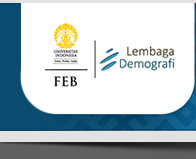Jurnal Ekonomi Kependudukan dan Keluarga
Abstract
The weakening purchasing power of the middle class in Jakarta due to income stagnation and rising prices has encouraged the search for additional sources of income. The gig economy, which offers flexibility and higher income opportunities, is a potential alternative. This study aims to analyze the characteristics of middle-class workers and gig workers and measure the potential of the gig economy in increasing income. Analysis of the 2023 National Labor Force Survey (Sakernas) shows that 82.42% of Jakarta workers are middle class, the majority of whom have a high school education with an average income of 4.8 million rupiah per month. Meanwhile, gig workers with shorter working hours (44 hours/week) have an average income of 7 million rupiah. The results of the Propensity Score Matching (PSM) show the difference in income between gig and non-gig workers is 293,432 rupiah, increasing to 1,559,339 rupiah without the transportation sector. Logistic regression confirms that education, experience, and working hours have a significant effect on the opportunity to work in the gig economy. This finding emphasizes the importance of gig economy to potentially be the additional source of income for the middle-class workers, especially through skilled gig jobs. Therefore, the government needs to provide experience-based training (experiential learning) and promote the gig economy as a strategy to improve the welfare of middle-class in Jakarta.
References
Agresti, A. (2013). Categorical Data Analysis. In International encyclopedia of statistical science (Third, Vol. 47, Issue 4). John Wiley & Sons, Inc.
Aisha, R. (2019, December 18). Kelas Menengah yang Terlupakan. https://jpi.or.id/blog/kelas-menengah-yang-terlupakan
BPS Provinsi DKI Jakarta. (2024a). Provinsi DKI Jakarta Dalam Angka 2024 (T. Parwati, Ed.). BPS Provinsi DKI Jakarta. https://jakarta.bps.go.id/publication/2024/02/28/baae7b80d16101c7bef30cc0/provinsi-dki-jakarta-dalam-angka-2024.html
BPS Provinsi DKI Jakarta. (2024b, July 17). Laju Pertumbuhan PDRB menurut Pengeluaran [Seri 2010] (Persen). https://jakarta.bps.go.id/indicator/156/66/1/laju-pertumbuhan-pdrb-menurut-pengeluaran-seri-2010-.html
Caliendo, M., & Kopeinig, S. (2005). Some Practical Guidance for the Implementation of Propensity Score Matching.
Faisal, A. L. F., Sucahyo, Y. G., Ruldeviyani, Y., & Gandhi, A. (2019). Discovering Indonesian Digital Workers in Online Gig Economy Platforms. 2019 International Conference on Information and Communications Technology (ICOIACT), 554–559. https://ieeexplore.ieee.org/document/8938543
Hamadeh, N., Catherine, V. R., & Emetreau, E. (2023). World Bank Group country classifications by income level for FY24 (July 1, 2023- June 30, 2024). The World Bank, 24. https://blogs.worldbank.org/en/opendata/new-world-bank-group-country-classifications-income-level-fy24
Hanivan, H., & Rakhmawan, S. A. (2023). Gig Economy During Pandemic in East Java. East Java Economic Journal, 7(1), 69–89. https://doi.org/10.53572/ejavec.v7i1.88
Hemmert, G. A. J., Schons, L. M., Wieseke, J., & Schimmelpfennig, H. (2018). Log-likelihood-based Pseudo-R2 in Logistic Regression: Deriving Sample-sensitive Benchmarks. Sociological Methods and Research, 47(3), 507–531. https://doi.org/10.1177/0049124116638107
Hirano, K., Imbens, G. W., & Ridder, G. (2003). Efficient estimation of average treatment effects using the estimated propensity score. Econometrica, 71(4), 1161–1189. https://doi.org/10.1111/1468-0262.00442
Khandker, S., Gayatri, S., & Hussain, K. (2010). Handbook on Impact Evaluation. In Learning (Vol. 1, Issue 1). http://documents1.worldbank.org/curated/en/650951468335456749/pdf/520990PUB0EPI1101Official0Use0Only1.pdf
Kolb, D. A. (2014). Experiential Learning: Experience as the Source of Learning and Development. Pearson Education. https://books.google.co.id/books?id=jpbeBQAAQBAJ
Morgan, C. J. (2018). Reducing bias using propensity score matching. In Journal of Nuclear Cardiology (Vol. 25, Issue 2, pp. 404–406). Springer New York LLC. https://doi.org/10.1007/s12350-017-1012-y
Mulyaningsih, T., Adhitya, D., & Rosalia, A. C. T. (2021). Education, skills and labour market outcome in Indonesia: An instrumental variable approach. Economic Journal of Emerging Markets, 13(2), 168–177. https://doi.org/10.20885/ejem.vol13.iss2.art6
Permana, M. Y., Izzati, N. R., & Wahyudi Askar, M. (2023). Measuring the Gig Economy in Indonesia: Typology, characteristics, and distribution. https://ssrn.com/abstract=4349942
Rubin, D. B. (2001). Using Propensity Scores to Help Design Observational Studies: Application to the Tobacco Litigation. Health Services and Outcomes Research Methodology, 2(3/4), 169–188. https://doi.org/10.1023/A:1020363010465
Santika, E. F. (2024). Proyeksi Pangsa Pasar e-Commerce Global hingga 2028, Naik Signifikan?
Sihombing, R. S. T. S., Handoko, M., Joellen, R. C., & Tjitrajaya, Y. A. (2024). Analisis Kualitas Kerja Pekerja Gig di Jawa Barat: Tinjauan Berbasis Data Sakernas Agustus 2019-2022.
Soebandrija, K. E. N., Said, L. R., Utomo, P., & Nabila, R. (2021). Gig Economy : Concepts, Opportunities and Challenges. Diandra Kreatif. www.diandracreative.com
Soesilowati, E., & Salim, Z. (2009). The Paradox of Education, Productivity and Career Development. Journal of Indonesian Social Sciences and Humanities, 2, 69–94. https://doi.org/10.14203/jissh.v2i0.17
The World Bank. (2019). Aspiring Indonesia-Expanding the Middle Class. https://www.worldbank.org/en/country/indonesia/publication/aspiring-indonesia-expanding-the-middle-class
Bahasa Abstract
Pelemahan daya beli penduduk kelas menengah di Jakarta akibat stagnasi pendapatan dan kenaikan harga mendorong pencarian sumber penghasilan tambahan. Ekonomi gig, yang menawarkan fleksibilitas dan peluang pendapatan lebih tinggi, menjadi alternatif potensial. Penelitian ini bertujuan untuk menganalisis karakteristik pekerja kelas menengah dan pekerja gig serta mengukur potensi ekonomi gig dalam meningkatkan pendapatan. Analisis Survei Angkatan Kerja Nasional (Sakernas) 2023 menunjukkan bahwa 82,42% pekerja Jakarta tergolong kelas menengah, mayoritas berpendidikan SMA dengan pendapatan rata-rata 4,8 juta rupiah per bulan. Sementara itu, pekerja gig dengan ketrampilan bekerja lebih singkat (44 jam/minggu) dengan rata-rata penghasilan sebesar 7 juta rupiah. Hasil Propensity Score Matching (PSM) menunjukkan selisih pendapatan pekerja gig dan non-gig sebesar 293.432 rupiah, meningkat menjadi 1.559.339 rupiah tanpa sektor transportasi. Regresi logistik mengonfirmasi bahwa pendidikan, pengalaman, dan jam kerja berpengaruh signifikan terhadap peluang bekerja di ekonomi gig. Temuan ini menunjukkan bahwa ekonomi gig berpotensi menjadi sumber pendapatan tambahan bagi kelas menengah, terutama melalui pekerjaan yang membutuhkan keterampilan. Oleh karena itu, pemerintah perlu menyediakan pelatihan berbasis pengalaman (experiential learning) dan mempromosikan ekonomi gig sebagai strategi peningkatan kesejahteraan kelas menengah di Jakarta.
Recommended Citation
Arafat, La Ode Ahmad; Pratama, Siectio Dicko; and Rahadiana, Rizal
(2025)
"GIG Economy sebagai Sumber Ekonomi Baru Penduduk Kelas Menengah di Jakarta,"
Jurnal Ekonomi Kependudukan dan Keluarga: Vol. 2:
No.
1, Article 3.
DOI: 10.7454/jekk.v2i1.1064
Available at:
https://scholarhub.ui.ac.id/jekk/vol2/iss1/3





